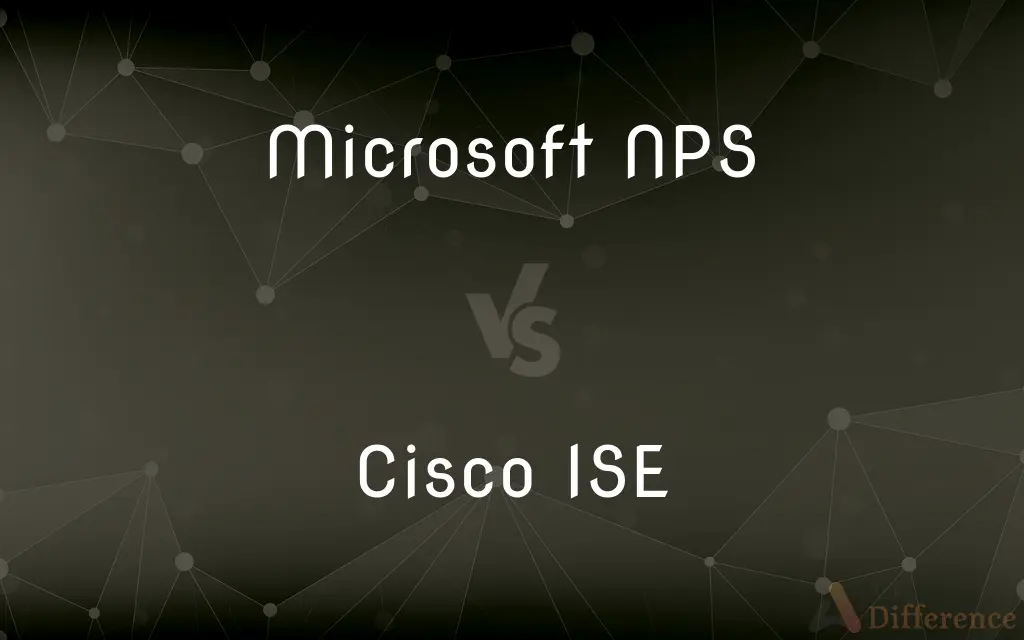Microsoft NPS vs. Cisco ISE — What's the Difference?
Edited by Tayyaba Rehman — By Fiza Rafique — Published on December 2, 2023
Microsoft NPS (Network Policy Server) is a Windows server role for RADIUS authentication, while Cisco ISE (Identity Services Engine) is a comprehensive solution for network access control and policy enforcement.

Difference Between Microsoft NPS and Cisco ISE
Table of Contents
ADVERTISEMENT
Key Differences
Microsoft NPS is a component available within the Windows Server operating system. As a RADIUS server, it centralizes the management and enforcement of network access policies. Cisco ISE, on the other hand, offers a broader range of services, combining RADIUS functionalities with additional features like guest networking and posture assessment.
While both Microsoft NPS and Cisco ISE aim to manage network access securely, their approach and scale differ significantly. Microsoft NPS generally focuses on the basics of RADIUS authentication, ensuring that networked devices and users adhere to specific access criteria. Cisco ISE, in contrast, provides a more holistic view of network security, embedding context-awareness into its policies and allowing for more granular control.
In the context of infrastructure and setup, Microsoft NPS is often chosen by organizations already heavily invested in Microsoft ecosystems, seeking straightforward RADIUS functionalities. Cisco ISE, being more feature-rich, is commonly adopted by enterprises in need of advanced security solutions, allowing them to integrate and coordinate various security protocols across their network.
Finally, the choice between Microsoft NPS and Cisco ISE often comes down to organizational needs, budget, and existing infrastructure. Microsoft NPS provides an essential, straightforward solution, while Cisco ISE offers a comprehensive platform for more complex network security requirements.
Comparison Chart
Primary Function
RADIUS server for authentication
Network access control and policy enforcement
ADVERTISEMENT
Integration
Primarily with Windows environments
Integrates with a broad range of devices and systems
Feature Set
Basic RADIUS functionalities
Comprehensive, including posture assessment and guest networking
Target Users
Organizations needing basic RADIUS services
Enterprises requiring advanced security solutions
Infrastructure Compatibility
Best suited for Microsoft-centric infrastructures
More versatile with multi-vendor environments
Compare with Definitions
Microsoft NPS
Tool for centralized authentication, authorization, and accounting.
Microsoft NPS allowed them to audit user access to network resources.
Cisco ISE
Comprehensive solution for network access control.
The organization adopted Cisco ISE to gain better visibility into network users.
Microsoft NPS
Component of Windows Server for network policy management.
With Microsoft NPS, the IT department centralized their network access policies.
Cisco ISE
Unified tool for guest networking, posture assessment, and more.
The university used Cisco ISE to manage guest Wi-Fi access during events.
Microsoft NPS
Microsoft's solution for network access security.
After migrating to Windows Server, they implemented Microsoft NPS for improved security.
Cisco ISE
Context-aware security solution for wired, wireless, and VPN connections.
By deploying Cisco ISE, the bank ensured secure remote access for its employees.
Microsoft NPS
Windows-based RADIUS server solution.
The company used Microsoft NPS to manage authentication on their wireless network.
Cisco ISE
Platform for enforcing security policies across a network.
With Cisco ISE, they could apply granular access policies based on user roles.
Microsoft NPS
Server role for enforcing network access policies.
They configured VPN authentication through Microsoft NPS.
Cisco ISE
Cisco's engine for identity and policy enforcement in networks.
The healthcare provider chose Cisco ISE to comply with strict data security regulations.
Common Curiosities
Can Microsoft NPS integrate with non-Windows systems?
Yes, though it's primarily designed for Windows ecosystems.
What is the role of a RADIUS server like Microsoft NPS?
To centralize authentication, authorization, and accounting for network access.
Is Cisco ISE limited to large enterprises?
No, but its advanced features often appeal to larger organizations.
What is the primary purpose of Microsoft NPS?
It serves as a RADIUS server for authentication within Windows environments.
How does Cisco ISE enhance network security?
By providing context-aware access control, posture assessment, and more.
What's the cost implication of Microsoft NPS vs. Cisco ISE?
Microsoft NPS is generally more affordable, while Cisco ISE offers more features at a higher cost.
Does Cisco ISE replace the need for a RADIUS server?
No, Cisco ISE incorporates RADIUS functionalities within its broader feature set.
How does Microsoft NPS handle policy violations?
It denies access based on predefined network policies.
Can Cisco ISE integrate with other Cisco security solutions?
Yes, it often works alongside other Cisco products for a coordinated security approach.
Is user experience affected when implementing Microsoft NPS or Cisco ISE?
With proper configuration, both can enhance user experience by ensuring secure and efficient access.
Do both solutions offer auditing capabilities?
Yes, both allow for tracking and auditing of network access events.
How does scalability compare between Microsoft NPS and Cisco ISE?
While both are scalable, Cisco ISE is often favored in large, complex networks due to its comprehensive features.
Which solution is better for a small business?
It depends on specific needs, but a small business may find Microsoft NPS sufficient for basic RADIUS functionalities.
Is Microsoft NPS exclusive to wireless network management?
No, it can manage both wired and wireless network access.
How does Cisco ISE support BYOD initiatives?
By offering device profiling, posture assessment, and differentiated access policies.
Share Your Discovery

Previous Comparison
Axial Skeleton vs. Appendicular Skeleton
Next Comparison
Active Learning vs. Passive LearningAuthor Spotlight
Written by
Fiza RafiqueFiza Rafique is a skilled content writer at AskDifference.com, where she meticulously refines and enhances written pieces. Drawing from her vast editorial expertise, Fiza ensures clarity, accuracy, and precision in every article. Passionate about language, she continually seeks to elevate the quality of content for readers worldwide.
Edited by
Tayyaba RehmanTayyaba Rehman is a distinguished writer, currently serving as a primary contributor to askdifference.com. As a researcher in semantics and etymology, Tayyaba's passion for the complexity of languages and their distinctions has found a perfect home on the platform. Tayyaba delves into the intricacies of language, distinguishing between commonly confused words and phrases, thereby providing clarity for readers worldwide.













































